Winter’s frigid temperatures and bleak grays can make December through March feel lifeless, but Mother Nature still provides vibrant fruits that taste their very best when grown in the cold. Altering your menu to embrace the flavors of winter helps your restaurant stay relevant all season long. Read below about the winter fruits that are in season in your region.
Winter Fruits Video List
Check out the video below for a visual reference of some of the most commonly used winter fruits:
Best Winter Fruits
Below is a list of fruits that grow in the winter.
1. Pomegranate
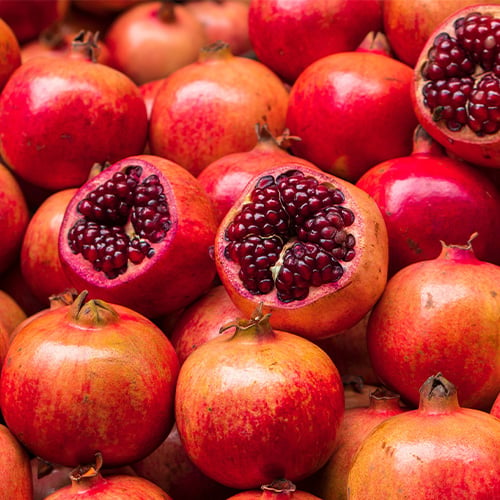
Pomegranates are one of the most iconic winter fruits, and also the most notoriously hard to open. A pomegranate has a thick outer shell with a red coating and a white inner casing. This shell is protecting small little seed-like fruits that have a juicy center. These are called pomegranate arils, and they’re the part of the pomegranate that you eat.
- Pomegranate Season: October - early January
- What does pomegranate taste like? Balanced sweet and tart flavor
- Can you eat pomegranate seeds? Yes, you can eat pomegranate seeds! Pomegranate seeds, also known as arils, are a great source of vitamins and nutrients.
How to Open a Pomegranate
To open a pomegranate, take your sharpest knife and cut off the stem of the pomegranate. From there, you will see how the pomegranate splits off into natural sections. Following those sections, score the outside of the pomegranate. Slowly take turns scoring it until you make it all the way to the center. Once all of the sections are scored, slowly break open the pomegranate.
How to Use a Pomegranate
Once you have your pomegranate arils, you can leave them whole or juice them. Use whole pomegranate arils to top salads, whipped feta or goat cheese spreads, or finished meat dishes. Pomegranate juice is great when made into a demi-glace, added minimally to smoothies, or used in desserts like chocolate hazelnut or almond cakes, pot de creme, cheesecakes, and sorbet.
What Goes with Pomegranate?
Pomegranate’s dark, sweet, and tart flavor pairs immensely well with honey, pistachios, chocolate, and different cheeses like feta, goat, brie, and cream cheese. It also pairs well with other berries, vegetables such as fennel, leeks, arugula, and kale, and proteins like steak, chicken, tofu, and lamb.
2. Clementine
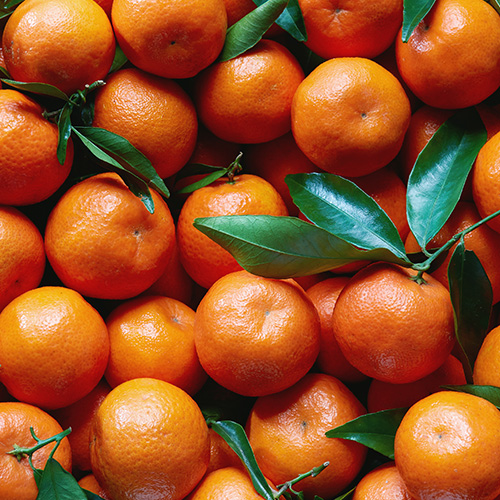
A clementine is a type of hybrid orange that combines a sweet orange and a willowleaf mandarin orange. Clementines can be anywhere between golf ball-sized to kiwi-sized and have a glossy and vibrant orange outer casing. Sometimes clementines are referred to by the brand names "Halos" and "Cuties" as they are the largest suppliers of clementines.
- Clementine Season: October - January
- What does clementine taste like? Refreshing and notably sweeter than other orange varieties
How to Use a Clementine
Clementines are wonderful by themselves, making them a great snack. However, you can also pop the skin-free segments of the clementine into a blender and strain it through a fine mesh sieve. This leaves you with the juice of a clementine, and your possibilities are endless. Use this juice in anything from sorbets, ice creams, frostings, and cheesecakes. Anything that can channel an orange creamsicle flavor is great!
What Goes with Clementine?
Flavors that pair well with clementines are dark chocolate, custards, blueberries, kiwis, honey, and winter fruits. For a savory meal, pair clementines with chicken, prosciutto, tofu, sesame, and cashews.
3. Persimmon
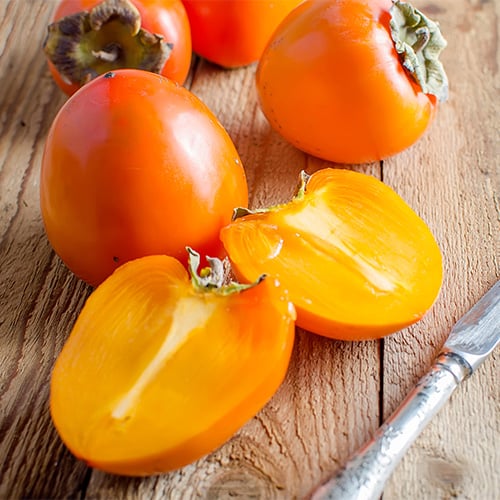
A persimmon is a type of winter fruit that looks like a waxy and sturdier tomato, but ranges in colors from sunset yellow to a vibrant orange mixed with a drop of red. It’s important to only eat a persimmon when it’s ripe, so look for persimmons that have a slight give to them.
- Persimmon Season: October - late December
- What does a persimmon taste like? If the persimmon is ripe, it tastes of honey with hints of dates. If it’s not ripe, it is extremely astringent.
How to Cut a Persimmon
To cut a persimmon, first core out the top leaves and stem. You can peel the skin off with a knife, or you can leave it on. This depends on your intended application. Then, finish preparing the persimmon by choosing whatever knife cut style you need for your recipe. If the persimmon is for snacking purposes, then cutting it into wedges is best.
How to Use a Persimmon
Persimmon’s uses feel endless as this winter fruit is so easily adaptable to sweet or savory recipes. For sweet applications, try using persimmons to make puddings, compote, jam, quick bread, cakes, and pies.
For savory recipes, use persimmons to make persimmon vinegar ("gamsikcho" in Korean). Try juicing persimmons for a marinade, pickle or ferment them, or serve them raw (with maybe a drizzle of honey!) alongside mild cheeses or on top of salads. Plus, persimmons are so beautiful that they make an excellent cocktail garnish.
What Goes with Persimmon?
Persimmon’s sweet flavor pairs nicely with different cinnamons and is complementary to any fruit. For a salty pairing, try placing persimmons on a charcuterie board next to cold cuts like prosciutto and a variety of different cheeses like goat, feta, and burrata.
4. Passion Fruit
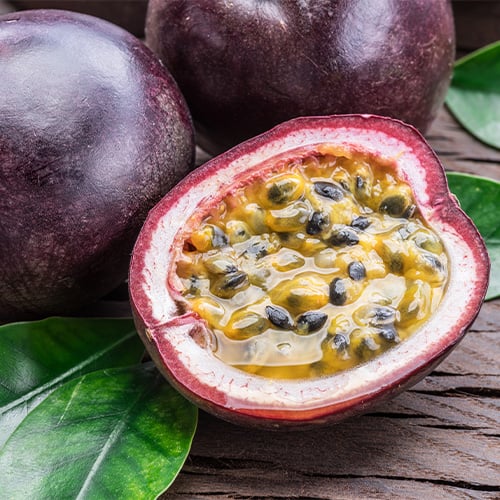
Passion fruits are a type of tropical fruit that has a portion of their growing and harvesting period during the winter. Passion fruit is also known as liliko'i in Hawaiian. This winter fruit comes in two different varieties: purple passion fruit and yellow passion fruit. Purple passion fruit has a hard purple shell, jelly-like golden pulp, and black seeds. Yellow passion fruit has a hard yellow shell, jelly-like golden pulp, and brown seeds.
- Passion Fruit Season: Mid-summer - mid winter
- What does passion fruit taste like? Tart, acidic, and a hint of sweetness
How to Cut Passion Fruit
Make sure your passion fruit is ripe before cutting it. The skin should be wrinkly, indicating its ripeness. To cut the passion fruit, use a serrated knife to cut the passion fruit right down the middle. You will now see the inner pulp and seeds. You can use the pulp right then and there, but some people do not like passion fruit's tart-tasting seeds. To remove the seeds, place a fine mesh strainer over a bowl and scoop out the pulp into the strainer. Using the back of a spoon, scrape the pulp back and forth until the pulp falls through the strainer and the seeds remain.
How to Use a Passion Fruit
If you want to keep the seeds in the pulp, then use passion fruit to top smoothie bowls, cheesecakes, cakes, and pavlovas. If you want to have a seed-free pulp, then make passion fruit curd, AKA lilikoi butter, to fill donuts like malasadas, make passion fruit bars, fill cakes and pate a choux desserts, or as an ingredient in raw vegan desserts.
What Goes with Passion Fruit?
Passion fruit's best pairing is with a dairy-based ingredient to cut its tartness, so try recipes with yogurt, cream, and custard. When pairing passion fruit with other fruits, try papaya, melons, banana, and mangoes.
5. Pear
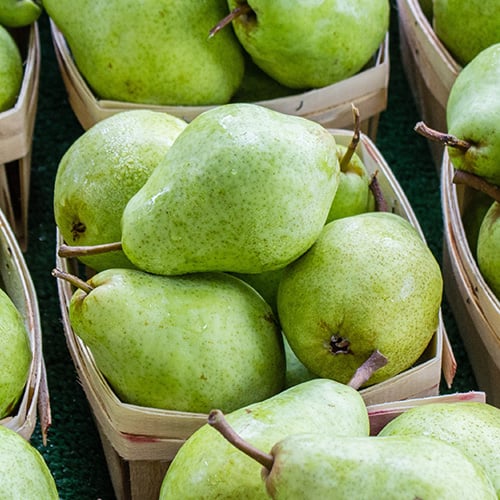
Pears are an excellent fall and winter fruit to enjoy during the cold seasons. There are many different types of pears, each with its own intended applications, so it's important to know which your recipe calls for. The most popular pear types are Bartlett, Bosc, and Anjou.
- Pear Season: August - January
- What does pear taste like? Smooth, sweet, mild, and slightly citrusy and tart
How to Use a Pear
Pears are a very versatile fruit and can be poached in wine, diced and added to sangrias, baked into fall and winter desserts like chocolate pear cake, or roasted or grilled for main entrees. They’re also a perfect addition to salads to provide a crisp, refreshing, and sweet flavor.
What Goes with Pear?
Pears complement fall flavors, such as cinnamon, ginger, and chai. Herbs to use with pears are thyme, tarragon, chives, and mint. Other great pairings for pears are hazelnuts, pecans, walnuts, nutmeg, caramel, honey, and different maple syrups. For an extra special dessert, use dark chocolate, brandy, or red wine with pears.
6. Grapefruit
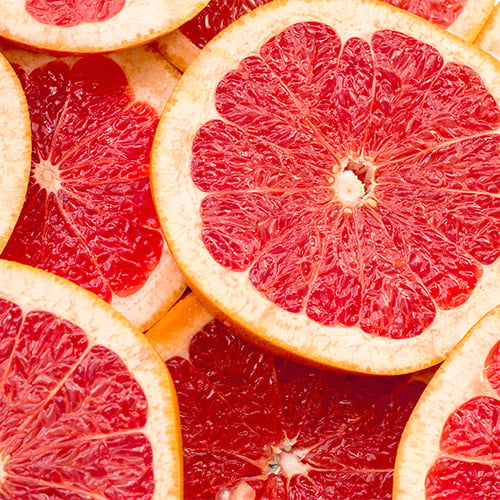
Grapefruits are usually thought of as summer fruits, but they're actually in season during the winter! Their vibrant pink flesh and bright taste really break up the gray and dry winter, so add grapefruits where you can on your winter menu.
- Grapefruit Season: November - March
- What does grapefruit taste like? Sour, bitter, and subtle hints of sweetness
How to Use a Grapefruit
Grapefruit’s tart flavor palette makes the perfect balancing act for sweet and salty foods. Try using grapefruit segments to decorate creamy yogurt cakes or panna cottas. Make grapefruit curd and fill them into tart shells or use them for grapefruit bars. On the savory side, they’re unbeatable in salads. Or, you can blend and strain a grapefruit and measure out the juice to make beautifully crafted winter cocktails or housemade bitters.
What Goes with Grapefruit?
Grapefruits complement bright herbs like mint and parsley, as well as savory herbs like thyme and rosemary. It also goes with tons of different vegetables: kale, spinach, fennel, and jicama. Grapefruit pairs with almost any fruit, especially the ultra-sweet taste of pineapple. Additionally, grapefruit is perfect with dairy-based foods like buffalo, ricotta, and feta cheese as well as yogurt.
7. Lemon
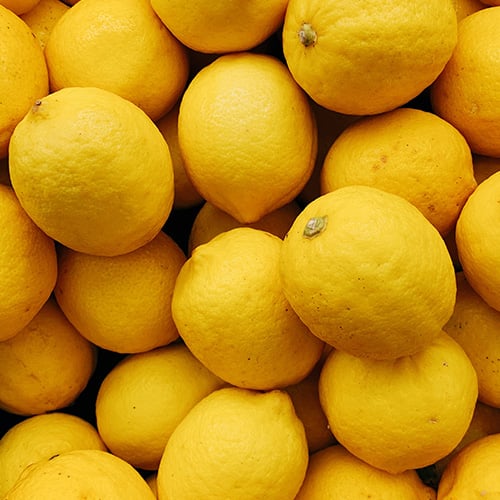
Lemon is another summer-associated citrus fruit that is actually a winter fruit! Lemons add the perfect acidic contrast to salty or sweet recipes to balance out all of the complex flavors. Regular lemons are great, but also be sure to try pink lemons and Meyer lemons!
- Lemon Season: November - April
- What does lemon taste like? Sour, acidic, and harsh
How Much Juice in One Lemon?
There are approximately 3 Tablespoons of juice in one lemon.
How to Use a Lemon
Lemons are truly the most versatile fruit. If you want to use your lemons as the star of the show in a recipe, you can’t beat a lemon meringue pie, lemon sorbet, lemon bars, and lemon pound cake. For savory dishes, use a squeeze of fresh lemons to brighten up any dish or make a tangy vinaigrette. Or, try using lemons in drinks, like a blueberry lemonade vodka punch or house-made limoncello.
What Goes with Lemon?
While almost all foods go with lemon, there are a few stand-out ingredients that really shine with this winter fruit. Blueberries, blackberries, and honey are wonderful with lemons and ultra-sweet fruits like grapes, coconut, and pineapple. Ginger, pepper, basil, all seafood, and chicken pair excellently with lemons, too.
8. Pomelo
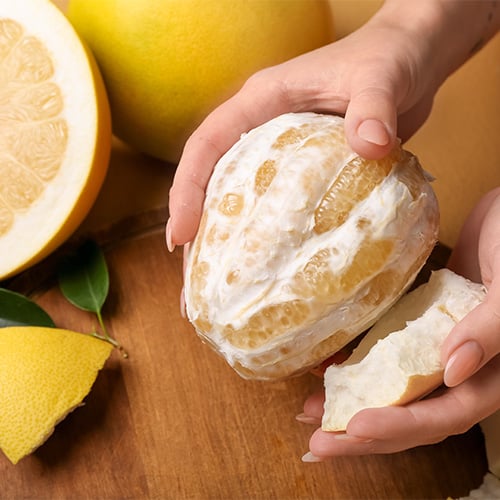
A pomelo is a citrus fruit that’s closely related to the grapefruit, but sweeter and in the shape of a teardrop. This winter fruit is said to be one of the oldest fruits in the world and originated in Asia. The skin is peelable like most citrus fruits and naturally divided up into segments.
- Pomelo Season: December - February
- What does pomelo taste like? Similar to grapefruit but far less bitter and acidic with a slightly higher sweetness
How to Use a Pomelo
Pomelos can have the same recipe applications as grapefruit. Use pomelo pieces in salads or make pomelo curd and use it in tarts or pomelo bars. You can also juice the pomelo and use it as a marinade for meats, a sauce for proteins, or add a splash into a stir fry.
What Goes with Pomelo?
Pomelo pairs well with herbs like mint, cilantro, and basil. When pairing with other fruits, try using ultra-sweet and tropical fruits like mangoes, coconuts, and pineapples. For vegetables, lean more towards extra crispy and fresh varieties like carrots, jicama, fennel, radishes, and chilis. For protein, use chicken and peanuts.
9. Kumquat
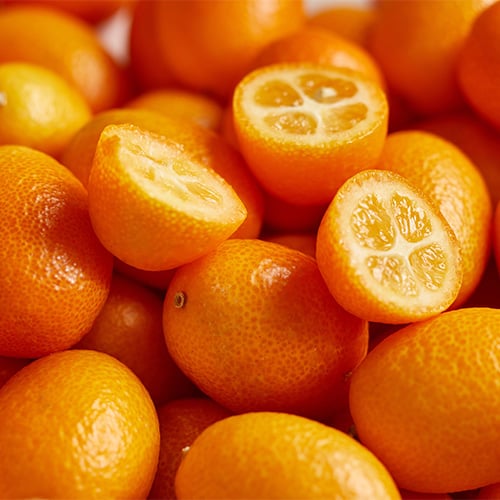
A kumquat is a winter fruit that closely resembles an orange in color, but is only the size of an olive. With kumquats, you are supposed to eat the sweet outer skin to balance out the tart inner flesh.
- Kumquat Season: December - March
- What does kumquat taste like? Similar sweetness to orange varieties with hints of tart lemons
How to Use a Kumquat
Kumquats are commonly made into jellies or marmalades, freshly cut and topped on winter salads, candied for cheesecakes, or made into syrup for drinks like bubble tea.
What Goes with Kumquat?
Kumquats pair well with dairy ingredients like cheese and yogurt. They also pair well with herbs and spices like rosemary, mint, ginger, and vanilla. Steak, tofu, pork, chicken, duck, and fish are great proteins to use, and chocolate and fruits are unbeatable.
It’s time to embrace the winter harvest with a new menu that reflects the season’s produce. Adding winter fruits to your food or drink recipes is just one way to attract customers to your bar during the winter, or to liven up your smoothie shop with new ingredients.



